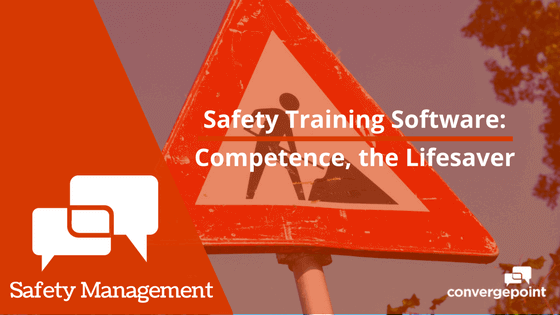Safety Training Software: Competence is a Lifesaver

Competence Is A Lifesaver
‘Competence’ is a very loaded word in the safety field. It is loaded because it carries significance and imparts a sense of importance that denotes skill and understanding. Competence speaks to a cluster of related abilities, commitments, knowledge and skills that enable a person to act effectively (and correctly) for a given job, task or situation. When it is claimed that someone is ‘competent’ it means that they have demonstrable ability to apply specific knowledge and skills. To be competent is to be in a state or have the quality of being adequately or well qualified for something that is specific and (usually) measurable in some way; hence its importance in safety.
OSHA has provided some guidance regarding what constitutes a “competent person”. According to the agency as per 29 CFR 1926.32(f), it means, “one who is capable of identifying existing and predictable hazards in the surroundings or working conditions which are unsanitary, hazardous, or dangerous to employees, and who has authorization to take prompt corrective measures to eliminate them”. It is a definition of a competent person that is very specific to the safety field and gives clear precedence to the importance of hazards and hazardous conditions in safety. OSHA has provided other criteria with regard to what constitutes a competent person. For example, with regard to scaffolding, OSHA states that a competent will be dependent “on the situation in which the competent person is working”. Therefore, in OSHA’s opinion, competency is also contextual and not merely an all-inclusive title for a person.
OSHA does recognize the importance of training as an important aspect of ascertaining competency, as well as knowledge. The former is usually formal, whilst the latter can be acquired by means of formal education and training, as well as via work experience and the acquisition of expertise. However, in an open letter dated May 21st, 1999, OSHA did warn that specific training may not be required for certain types of competency. Rather, OSHA was of the opinion that a competent person could also be defined as such “in terms of [their] capability”.
So many definitions and angles for so simple a word, and yet how is a company to always know if an employee has attained competency? The law is not as prescriptive as safety managers would like. Where there is uncertainty on how to establish competency, it is important to note that competency is important at both the technical and non-technical levels in safety management. One cannot only be declared technically competent – that is too myopic and too process-driven a focus. Importance too must be given to other types of competency that are non-technical; for example, a person can be declared systemically competent with regard to their experience in, and understanding of, management system issues in safety. An employee could even be designated as being competent with regard to hazard identification and risk assessments. What is important is that an organization should have the formal and comprehensive means by which competency can be both ascertained and ascribed.
As OSHA has cautioned, training is not the only means of attaining or assessing competency. It can nevertheless be a very helpful means by which competency can be ascertained. Thus, a proper training needs analysis can assist in ensuring that employees get the training they need and which can contribute to establishing or attesting to their competency. Training is also helpful in that it is usually formal, can allow for some form of assessment and is verifiable. However, just ‘sitting in a class’ will very often not suffice in determining an employee’s competency. Ultimately, competency needs to be demonstrated, not merely ‘certified’.
Your organization needs to have a standard in place with regard to what constitute ‘competence’ and a ‘competent person’. OSHA is not entirely instructive, and assessing non-technical competency in particular can be very tricky and even subjective. But a standard (or even standards pertaining to different jobs or departments) with regard to issues of competency must be formally established. Failure to do so could create inconsistencies and even a lack of oversight as to who is fully competent and who is not. In safety that could mean the difference between life and death.
